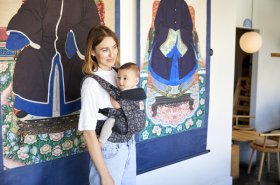In today’s modern parenting world, it’s hard to think that anything about the high-tech baby gadgets and parenting tools could connect us with our roots as humans. Even the baby carrier industry and all the bells and whistles of modern carriers seem anything but related to human evolution.
A closer look at the origins of early humans suggest that carriers may date back farther than one would think. In fact, the act of strapping baby to caregiver’s body is thought to have a very relevant history in the origins of early humans.
Among primates, parent-infant physical contact is a central part of the early infancy period. But our chimpanzee, bonobo, and orangutan relatives make it look easy: non-human primate babies can cling to parents with their inborn reflex for grasping in both the hands and the feet. They also have a good amount of body hair to grasp on their caregiver, leaving the adult hands-free to transport baby safely on land or in the trees.
Though newborn primate babies of the non-human variety are able to cling to their caregivers to maintain contact, there were several important changes in our evolution that prevented our human babies from being afforded the same skills. The loss of body hair was one of the most notable changes. Famously the “naked” ape of the animal kingdom, humans are the only primates without enough body hair to be functional for grasping. Another change was foot anatomy. Humans have an elongated foot and parallel-aligned toes ideal for bipedal (upright) walking, rather than for tree-swinging (and parent-grasping!) Lastly, human babies are notable for their big heads (and the accompanying big brains!) The problem with those big brains is that they are so big, they actually take much longer to develop than just the nine months of gestation. Human babies come into the world noticeably “immature” in the sense that their big brains are still developing. They are completely dependent on caregivers for everything, making it impossible for human babies to be self-sufficient during transit.
All of these factors coincided, tasking adults with carrying their very heavy, big-brained baby in their arms during long periods of upright, bipedal transit. A solution was needed. Anthropologists believe that this was the point at which tool development came to the rescue in the form of the very first infant carriers. One experimental analysis found that the burden of carrying baby is 16% greater in-arms than with a tool to support the baby’s weight. The authors even demonstrate that in-arms carrying is a greater energetic burden than lactation. Carrying babies is also thought to shorten the stride of the walker, making walking with a baby in-arms much less efficient. In a more recent experimental study, using a baby carrier facilitated a posture and biomechanical profile more similar to the body’s natural state versus in-arms carrying, which showed a more burdensome effect on the parent’s biomechanical state.
Simple ways to strap baby to the body may have allowed early humans to maintain the physical contact that babies biologically and psychologically need, while efficiently embracing their unique qualities of being an upright, hairless, big-brained primate. Though we cannot know for sure if and when infant carriers became one of the first parenting tools of early humans, all of these data combined paint a clear picture of the need of our ancestors to develop a solution to be able to travel efficiently with their heavy babies.
About the author: Emily Little, PhD, CLEC, is a perinatal health educator, researcher, and advocate, and is the Founder and Executive Director of Nurturely (nurturely.org). Emily conducts community-participatory research that combines approaches from anthropology, psychology, and public health to explore infant-caregiver interaction and perinatal health systems, with the end goal of improving policies and societal practices so all infants and caregivers can thrive. She is trained as a Certified Lactation Educator Counselor and trained Babywearing Educator and is passionate about co-creating preventative, community-led programs that facilitate equitable access to wellness during the perinatal period. Her work in Micronesia, Central and South America, and South Asia inspired her passion for strengthening cultures of support for infants and caregivers and promoting equity in all aspects of her work. Emily was a graduate of the CARTA graduate certificate program in Anthropogeny at University of California, San Diego, which was pivotal in fostering a desire to explore human origins.



